Priene, the ancient holy city of Ionia
Priene, the ancient holy city of Ionia and the home of an important temple of Athena.
The city of Priene, an Ionian settlement, was laid out on Mount Mycale (Samsun) and contained many famous examples of Hellenistic art and architecture. The original location of the city has never been found but it was probably a peninsula with two harbors. The ruins are from the new city built in the 4th century BC. It is a small city with 4 or 5 thousand inhabitants and not of great political significance even if it shared the same history with the other Ionian cities.
The city is mainly organized in four districts, the political (bouleuterion and prytaneion), the cultural (Theatre), commercial (agora) and most importantly religious (Athena Temple) In addition to the Athena Temple, the people of Priene erected sanctuaries dedicated to Zeus, Demeter and Egyptian gods.
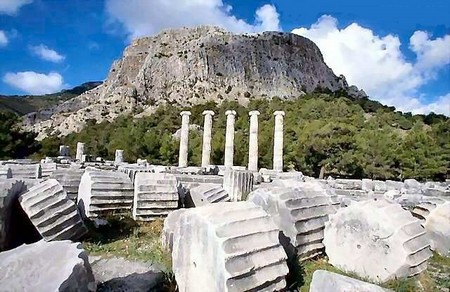
The city was a member of the Ionian League, and has been built at the base of an escarpment of Mycale mountain close to Meander (Buyuk Menderes) river, some 25 kilometres far away from the ancient city of Miletus. It was built at a place overlooking the Aegean sea on steep slopes and terraces extending from sea level to a height of 380 metres above sea level at the top of the escarpment. However today, after several centuries of changes in the landscape, it is an inland site.
The original Priene however was had been a port city situated at the then mouth of the Meander River. Remains of the original Priene have not yet been identified, because, it is supposed, they must be under many feet of sediment, the top of which is currently valuable agricultural land. Because of Meander river's depositions this old city had to be moved every few centuries in order to renew its utility as a port.
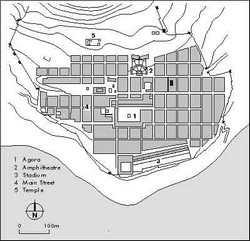 At about 350 BC the Persian-empire satrap, Mausolus (a Carian) planned a magnificent new city
on the steep slopes of Mycale, where it would be, it was hoped, a permanent deep-water port and
seem to delight in being located on and up a seaside escarpment. Construction had begun when the
Macedonians took the region from the Persian Empire and Alexander the Great personally assumed
responsibility for the move. Both he and Mausolus intended to make Priene a model city. He
offered to pay for construction of the Temple of Athena if it would be dedicated to him, which
it was, in 323 BC. The leading citizens were quick so most of the public buildings were
constructed at private expense and are inscribed with the names of the donors. So the city was
constructed according to a plan entirely within the 4th century BC.
At about 350 BC the Persian-empire satrap, Mausolus (a Carian) planned a magnificent new city
on the steep slopes of Mycale, where it would be, it was hoped, a permanent deep-water port and
seem to delight in being located on and up a seaside escarpment. Construction had begun when the
Macedonians took the region from the Persian Empire and Alexander the Great personally assumed
responsibility for the move. Both he and Mausolus intended to make Priene a model city. He
offered to pay for construction of the Temple of Athena if it would be dedicated to him, which
it was, in 323 BC. The leading citizens were quick so most of the public buildings were
constructed at private expense and are inscribed with the names of the donors. So the city was
constructed according to a plan entirely within the 4th century BC.
The ruins of the city are on of the most spectacular surviving examples of an entire ancient Greek city intact except for the ravages of time and has been studied since at least the 18th century. The city was constructed of marble from nearby quarries on Mycale and wood for such items as roofs and floors. The public area is laid out in a grid pattern up the steep slopes, drained by a system of channels. The water distribution and sewer systems survive. Foundations, paved streets, stairways, partial door frames, monuments, walls, terraces can be seen everywhere among toppled columns and blocks. No wood has survived. The city extends upward to the base of an escarpment projecting from Mycale. A narrow path leads to the Acropolis above.
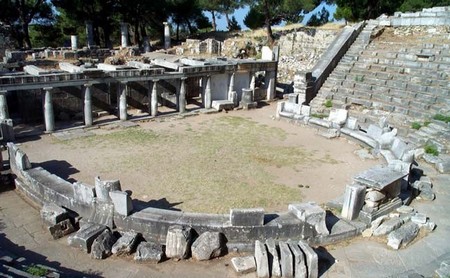
Despite the expectations of the population Priene lasted only a few more centuries as a deep-water port. In the 2nd century AD Pausanias reports that Maeander already had silted over the inlet in which Myus stood and that the population had abandoned it for Miletus. Apparently, Miletus was still open then, but Priene could not have been. Very likely, its merchants had preceded the people of Myus to Miletus. By 300 AD the entire Bay of Miletus, except for Lake Bafa, was silted in also.
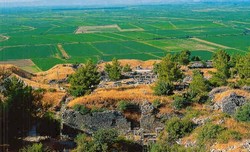 Today Miletus is many miles from the sea and Priene stands at the edge of a fertile plain, now a
checkerboard of privately owned fields. A Greek village remained after the population decline and
was joined by a Turkish population in the 2nd millennium. In the 13th century it was a primarily
Turkish village known by the name the Turkish population had assigned to the escarpment, Samsun Kale
or "Samson's Castle", where Samson had come to represent any mythical strong man.
Today Miletus is many miles from the sea and Priene stands at the edge of a fertile plain, now a
checkerboard of privately owned fields. A Greek village remained after the population decline and
was joined by a Turkish population in the 2nd millennium. In the 13th century it was a primarily
Turkish village known by the name the Turkish population had assigned to the escarpment, Samsun Kale
or "Samson's Castle", where Samson had come to represent any mythical strong man.
By 1923 whatever Greek population remained was expelled in the population exchange between Greece and Turkey and shortly after the Turkish population moved to a more favorable location, which they called Güllü Bahçe, "rose garden", the old Greek settlement partly still in use, today with the name Gelebeç or Kelebeş. The tourist attraction of Priene is accessible from there.
Priene was a wealthy city, as the plenitude of fine urban homes in marble and the private dedications of public buildings suggests, not to mention the personal attentions of Mausolus and Alexander the Great, and one third of them had indoor toilets.
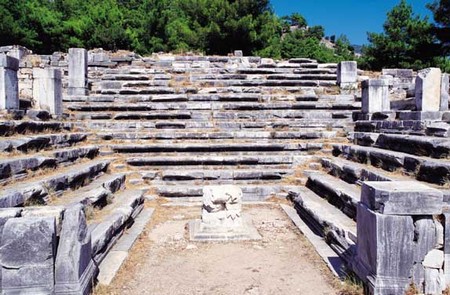
In 4th century BC Priene was a democracy. State authority resided in a body called "the Prieneian people", who issued all decrees and other public documents in their name. An assembly of citizens met periodically to render major decisions placed before them. The day-to-day legislative and executive business was conducted by the city council, which met in a bouleuterion like a small theatre with a wooden roof. The official head of state was a prytane. He and more specialized magistrates were elected periodically.
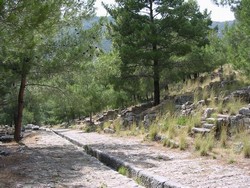 The ruins, which lie in successive terraces was laid out on a rectangular scheme. The steep area
faces south, the acropolis rising nearly 200 m behind it. The city was enclosed by a wall 2 m
thick with towers at intervals and three principal gates. On the lower slopes of the acropolis
was a sanctuary of Demeter. The town had six main streets, about 6 m wide, running east and west
and fifteen streets about 3 m wide crossing at right angles, all being evenly spaced and it was
thus divided into about 80 insulae. Private houses were apportioned eight to an insula. The
systems of water-supply and drainage can easily be discerned. The houses present many analogies
with the earliest Pompeian. In the western half of the city, on a high terrace north of the
main street and approached by a fine stairway, was the temple of Athena Polias, a hexastyle
peripteral structure in the ionic order built by Pytheos, the architect of the Mausoleum of
Maussollos at Halicarnassus, one of the seven wonders.
The ruins, which lie in successive terraces was laid out on a rectangular scheme. The steep area
faces south, the acropolis rising nearly 200 m behind it. The city was enclosed by a wall 2 m
thick with towers at intervals and three principal gates. On the lower slopes of the acropolis
was a sanctuary of Demeter. The town had six main streets, about 6 m wide, running east and west
and fifteen streets about 3 m wide crossing at right angles, all being evenly spaced and it was
thus divided into about 80 insulae. Private houses were apportioned eight to an insula. The
systems of water-supply and drainage can easily be discerned. The houses present many analogies
with the earliest Pompeian. In the western half of the city, on a high terrace north of the
main street and approached by a fine stairway, was the temple of Athena Polias, a hexastyle
peripteral structure in the ionic order built by Pytheos, the architect of the Mausoleum of
Maussollos at Halicarnassus, one of the seven wonders.
March 19, 2009
